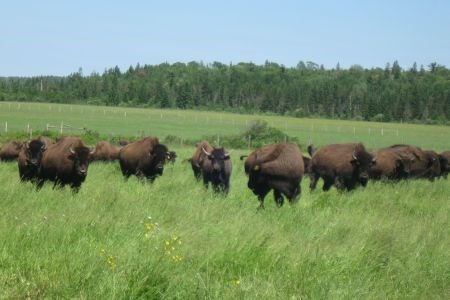With their tufted chins and ears splayed out like helicopter rotors, goats may seem unlikely saviours for the Algoma District farming community.
But preliminary research suggests promoting locally produced goat (chevon) and lamb across the region could be an antidote to a lagging agriculture sector, offering year-round sustainability in a sometimes finicky industry.
Instigated last December, the project is a collaboration between the Algoma Sheep and Lamb Producers Association and the NORDIK Institute in Sault Ste. Marie, and aims to measure demand for chevon and sheep, and determine how producers can meet consumers' needs.
Surveys have been distributed to both producers and consumers, and a pair of focus groups was held in June to glean consumers' consumption preferences. The goal is to determine the feasibility of setting up a market-based co-operative for lamb and chevon producers in the Algoma District.
Response so far has been positive, said NORDIK researcher David Thompson.
“There's a strong interest in having a marketing co-operative to service the local market,” he said. “In the past, a lot of people have shipped goat and lamb down south to stockyards, so that research already drew out that there's a desire for this.”
Roughly 63 per cent of red meat consumed worldwide is goat meat, especially in Muslim and Hindu cultures, where goat is preferred over beef, and researchers believe Algoma farmers can meet rising demand for product.
“Farmers are looking at many ways to diversify here in Algoma, and a lot of them are looking to things like maple syrup; another farmer does bison, and we have a lot of alpaca farmers in the area,” Thompson said. “So producers are really keen on that, and they're interested in this study to diversify what they have to offer.”
But the goat study is just one initiative being introduced to boost agriculture in the region.
Diversification was the driving force behind the 'Buy Algoma. Buy Fresh' farmers' directory, which lists more than 40 Algoma farmers and their products. Issued in both hard copy and online at www.buyalgoma.ca, the directory strives to promote awareness and access to locally sourced, wholesome foods.
Now in its second year, response to the directory has been “twice as good” as last year's inaugural issue, with more participation from producers, said NORDIK researcher Alexandra Jaffit, who works in tandem with the Algoma Marketing Alliance.
“It's more concise, there are more details and information on the online directory, and it's bringing it to the public's attention that all this stuff is available from farmers that you know and farmers that you can know,” Jaffit said. “This is their livelihood. They do it because they love it and their products reflect that.”
Released in June, consumers have said they discovered new farmers and products through the guide, while producers said word of mouth about their colleagues' success last year prompted them to participate.
“The numbers of farmers who came back to us and wanted to be on the directory again I think really speaks for itself,” Jaffit said.
The directory is on its way to becoming self-sustaining. This year, producers were charged a membership fee to be included in the directory, and its creators are planning to introduce advertising to the site.
“It's something that the farmers really see a lot of value in so we want to keep it for years to come,” Thompson said.
At the Sault Ste. Marie Innovation Centre, the Algoma Rural Agricultural Innovation Network (RAIN) has been established to foster innovation in agriculture with the intent of adding value to existing organizations, explained research director Errol Caldwell.
In today's climate, farmers are taking up secondary jobs to supplement their farming incomes, Caldwell said, which leaves them less time to lobby for agricultural and agri-forestry innovation.
“On the scheme of things in Ontario, Northern Ontario agriculture doesn't contribute as much as southern Ontario does, but it's exceptionally important up here and people's livelihoods are at stake,” Caldwell said. “With the Northern Ontario economy taking a nosedive, and some other sectors like forestry, it's really important to have a strong, vibrant and forward-thinking agriculture and related sector.”
RAIN is currently awaiting sufficient funding to move forward, but has attracted a number of collaborators, including the Algoma Federation of Agriculture, the Soil and Crop Improvement Association, the NORDIK Institute, cattlemen's associations, local municipalities and First Nations, as well as the East Algoma Chiefs, Mayors and Reeves Council.
In consultation with stakeholders, including First Nations, RAIN has determined infrastructure, research and development, and the marketing of non-timber forest products are major areas of interest.
Incentives currently offered for infrastructure initiatives “aren't strong enough,” Caldwell said, but something like adequate drainage could translate to a 30 to 40 per cent increase in cash crop production.
He also sees value in teaming up with the University of Guelph to focus on issues that are particular to the North and foresees a partnership with area First Nations, including the hiring of an Aboriginal specialist, to work with communities on opportunities for them such as harvesting products like wild foods or medicinal compounds.
If all goes well — and at “80 per cent there,” Caldwell is optimistic funding will come through and RAIN will hire a project co-ordinator and start moving forward on priority initiatives as early as the fall.
“The intent is to demonstrate that this is something that should become permanent and also to develop a strategy for long-term funding,” Caldwell said. “It's very much driven by rural interests, including agricultural producers and others. At the end of the day, this is meant for their benefit and if we're not benefitting them, we're not doing our job.”




